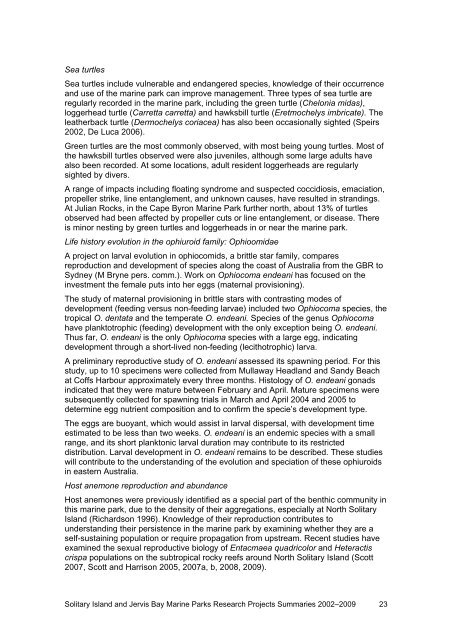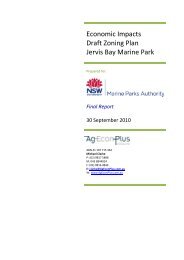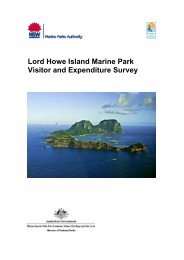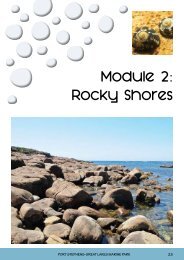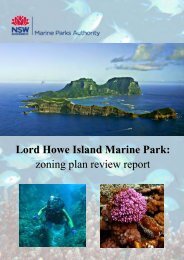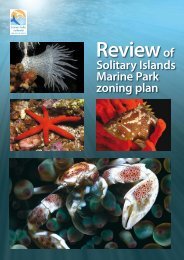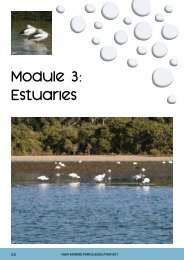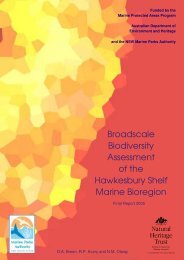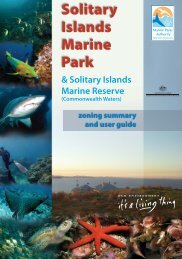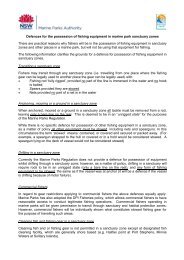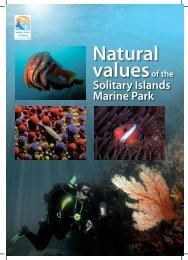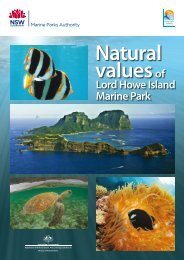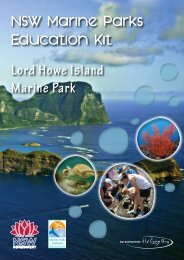Research Project Summaries 2002-2009 - Marine Parks Authority ...
Research Project Summaries 2002-2009 - Marine Parks Authority ...
Research Project Summaries 2002-2009 - Marine Parks Authority ...
You also want an ePaper? Increase the reach of your titles
YUMPU automatically turns print PDFs into web optimized ePapers that Google loves.
Sea turtlesSea turtles include vulnerable and endangered species, knowledge of their occurrenceand use of the marine park can improve management. Three types of sea turtle areregularly recorded in the marine park, including the green turtle (Chelonia midas),loggerhead turtle (Carretta carretta) and hawksbill turtle (Eretmochelys imbricate). Theleatherback turtle (Dermochelys coriacea) has also been occasionally sighted (Speirs<strong>2002</strong>, De Luca 2006).Green turtles are the most commonly observed, with most being young turtles. Most ofthe hawksbill turtles observed were also juveniles, although some large adults havealso been recorded. At some locations, adult resident loggerheads are regularlysighted by divers.A range of impacts including floating syndrome and suspected coccidiosis, emaciation,propeller strike, line entanglement, and unknown causes, have resulted in strandings.At Julian Rocks, in the Cape Byron <strong>Marine</strong> Park further north, about 13% of turtlesobserved had been affected by propeller cuts or line entanglement, or disease. Thereis minor nesting by green turtles and loggerheads in or near the marine park.Life history evolution in the ophiuroid family: OphioomidaeA project on larval evolution in ophiocomids, a brittle star family, comparesreproduction and development of species along the coast of Australia from the GBR toSydney (M Bryne pers. comm.). Work on Ophiocoma endeani has focused on theinvestment the female puts into her eggs (maternal provisioning).The study of maternal provisioning in brittle stars with contrasting modes ofdevelopment (feeding versus non-feeding larvae) included two Ophiocoma species, thetropical O. dentata and the temperate O. endeani. Species of the genus Ophiocomahave planktotrophic (feeding) development with the only exception being O. endeani.Thus far, O. endeani is the only Ophiocoma species with a large egg, indicatingdevelopment through a short-lived non-feeding (lecithotrophic) larva.A preliminary reproductive study of O. endeani assessed its spawning period. For thisstudy, up to 10 specimens were collected from Mullaway Headland and Sandy Beachat Coffs Harbour approximately every three months. Histology of O. endeani gonadsindicated that they were mature between February and April. Mature specimens weresubsequently collected for spawning trials in March and April 2004 and 2005 todetermine egg nutrient composition and to confirm the specie’s development type.The eggs are buoyant, which would assist in larval dispersal, with development timeestimated to be less than two weeks. O. endeani is an endemic species with a smallrange, and its short planktonic larval duration may contribute to its restricteddistribution. Larval development in O. endeani remains to be described. These studieswill contribute to the understanding of the evolution and speciation of these ophiuroidsin eastern Australia.Host anemone reproduction and abundanceHost anemones were previously identified as a special part of the benthic community inthis marine park, due to the density of their aggregations, especially at North SolitaryIsland (Richardson 1996). Knowledge of their reproduction contributes tounderstanding their persistence in the marine park by examining whether they are aself-sustaining population or require propagation from upstream. Recent studies haveexamined the sexual reproductive biology of Entacmaea quadricolor and Heteractiscrispa populations on the subtropical rocky reefs around North Solitary Island (Scott2007, Scott and Harrison 2005, 2007a, b, 2008, <strong>2009</strong>).Solitary Island and Jervis Bay <strong>Marine</strong> <strong>Parks</strong> <strong>Research</strong> <strong>Project</strong>s <strong>Summaries</strong> <strong>2002</strong>–<strong>2009</strong> 23


